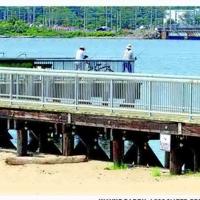PERTH AMBOY, N.J. — The federal government is providing over half a billion dollars to coastal communities to implement nature-based preventive measures to address climate-related flooding and other disasters.
The National Oceanic and Atmospheric Administration has announced a $575 million allocation for 19 resiliency projects in multiple states, focusing on Native American, urban, and traditionally underserved communities that face recurring floods, wildfires, and other weather-related disasters.
U.S. Secretary of Commerce Gina Raimondo stated that the initiative aims to enhance the resilience of America’s coastal communities against the impacts of climate change.
The projects include funding of over $72 million for “living shorelines” in New Jersey, utilizing native plants, oyster reefs, and other natural materials to restore and safeguard waterfronts. Additionally, funds are allocated for activities such as replacing sidewalks with permeable pavement, greening buildings to absorb heat, and creating parks in flood-prone areas to absorb floodwaters.
People are also reading…
Other efforts include climate risk assessments for more than 100 Native communities in Alaska, expanding tribal adaptation technical assistance statewide, and sharing local knowledge.
Furthermore, nature-based solutions are being employed to protect California’s Monterrey Bay, establish native forests for wildfire risk reduction in Hawaii, and create open spaces on Rhode Island’s Aquidneck Island.
NOAA and the U.S. Commerce Department officials held a news conference in Perth Amboy, New Jersey, to outline some planned work for the state, which was heavily impacted by Superstorm Sandy. The event took place on a bayfront walkway reconstructed using government recovery funds post the 2012 storm.
“Climate change is a reality, it is current, and it is urgent,” expressed Shawn LaTourette, the environmental protection commissioner of New Jersey. “Frequent flooding displacing families from their homes highlights the necessity for federal action and investment.”
This funding is part of NOAA’s Climate Resilience Regional Challenge funded through the Inflation Reduction Act.
Environmental organizations advocate for natural coastal protection over conventional “hard engineering” solutions like sea walls and bulkheads, which they argue can exacerbate erosion. Many coastal communities aim to integrate a blend of both shoreline protection types where solely nature-based solutions are insufficient.
Several projects emerging from this perspective include utilizing coconut husk fibers in mats by New Jersey’s American Littoral Society to stabilize eroding river shorelines.
U.S. Rep. Frank Pallone Jr., a Democrat from New Jersey, mentioned that several projects will incorporate rain gardens, “green roofs,” and permeable pavement to absorb rainwater and storm surges, diverting them from overwhelmed sewers.





